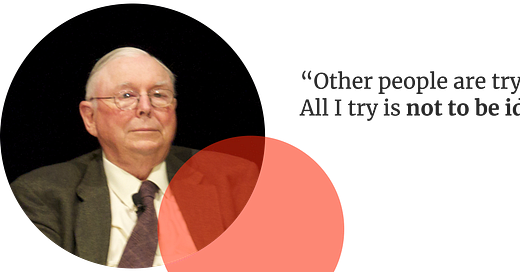“Illuminate stupidity”. A technique to identify mistakes before you make them
Hello Friends, In today’s letter
Exercise: The inversion technique for PMs inspired by investors.
Links: How not to conduct competitive research, unpopular opinions in software, and more.
P.S.: What I’m reading.
Technique to try: Inversion

The investor and thinker Charlie Munger is described in the book Richer, Wiser, Happier as “the Grand Master of Stupidity Reduction”.
He believes “trying to be consistently not stupid, instead of trying to be very intelligent” is the best way to get ahead in your life and career. To achieve this he uses the inversion technique.
The idea is to think about the worst-case scenario or try to predict what could go wrong. For example, to improve as a PM, instead of asking yourself “How can I be a better product manager”, ask yourself “How could I mess up?”.
Or when starting a project instead of asking “How can I make it a success?”, ask “How could it fail?”.
🏋️♂️ Exercise
The inversion technique is similar to the pre-mortem concept, where you envisage a project failing and then work backward to find out how it happened, tracing undesirable outcomes or mistakes to their source.
You can apply inversion to different areas of life, asking "What can delay the release?", "What can kill my company?", "How do I not finish the project on time?", "How can I destroy my finances?".
Option 1: Try inversion on your own
Step 1. Define the goal
Let’s say your company wants to expand to new markets where users don’t speak your language or, for B2B products, translation is a new client requirement. Your goal is to have users comfortably work with your product in their native language.
Step 2. Invert
Think in reverse and consider the opposite.
“How do I make product experience in other languages hell?”
Step 3. Brainstorm what can possibly go wrong
Make sure you cover it from different angles, from different stakeholders’ points of view, different touchpoints in the process.
Questions you might ask
What could cause us to miss our deadline?
What could stop us from starting?
How could personal relationships affect the outcome?
Which regulations might be relevant?
What could push us over budget?
How could team dynamics affect the outcome?
What knowledge and capabilities might we be missing?
What life events could delay the project?
How could it harm our reputation?
Could it hurt us financially?
Step 4.Prioritize
Pick the problems which are the most critical, have a high probability of happening, and which you can control.
For our localization mission it might be:
1. Broken interface. If the interface wasn’t designed with right-to-left or Cyrillic languages in mind this could result not only in an ugly UI but also unreadable texts and controls.
2. Incorrect translation. Especially critical for professional, financial products and services.
3. Not providing a full experience in the language. You need to think about the end-to-end experience: from documentation to support.
Step 5. Find a solution or create action points
For some problems, you might need to create an action point to research and find a solution or assign them to responsible people.
For our localization mission it might be:
1. Broken interface. Agree with the design team to conduct an audit of the interface and prepare designs to support new languages.
2. Incorrect translation. Find an industry specialist or agency, one which also understands any relevant cultural aspects, to carry out translation and review of the interface.
3. Not providing full experience in the language. Understand the user journey and address all important steps, hire people if necessary.
Option 2: Try inversion with a team
If you want to facilitate a discussion with a team:
Make sure you cover all important aspects and stakeholders so there are no blind spots (security, legal, sales, etc.), but keep the group under 5 people. If you need more people, split them into smaller groups.
Spend 5 minutes individually brainstorming everything that could possibly go wrong and then present ideas. Use one sticky note or virtual note per idea and cluster similar ideas in groups.
Prioritize problems by voting. Each member gets 3 votes and can use as many as they want for 1 problem.
Sources
Richer, Wiser, Happier: How the World’s Greatest Investors Win in Markets and Life by William P. Green.
The Profile Dossier: Charlie Munger, the Master of Mental Models.
🧠 Worth Learning
Articles, podcasts, and products I found useful, and maybe you will, too.
📖 Read Useless vs. Useful Competitive Analysis. “Shadow” experienced PMs and learn what to avoid when doing competitive analyses.
🎧 Listen to an entertaining discussion about unpopular opinions in software: work-life balance bullying, fail fast for B2B, creating roadmap by voting and scaling architecture before finding a market fit.
🔍 Analyze Google search trends of 2021. The world searched for how to start a business more than how to get a job in 2021.
🔖 Bookmark My favorite books, newsletters, and podcasts of 2021.
👩🔬 Study the on-demand service for celebrity videos Cameo.com. Think about how would you attract famous people to your platform? How would you make it valuable for them?
👩💻 P.S. What I'm reading
Passing by Nella Larsen is a short historical fiction novel about a fascinating cultural phenomenon. A story about old acquaintances who meet by chance at a restaurant where they are both "passing" since black people were not permitted. One of them even has a racist husband who has no idea his wife is black.
Please help me make this newsletter more useful by answering four quick questions.





